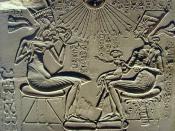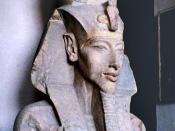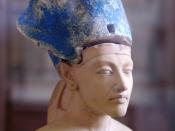Throughout the history of man, the societies which have been labeled as the 'pillars of civilization' have all had one common characteristic; excellence in the arts. Each society had developed styles which were relevant to their times and philosophies, yet when observed closely, one is able to find many common similarities within each.
When one thinks of the major contributions of each of these societies, several stick out as being distinct or superior to others. These 'distinct' societies include the Egyptian society the Greek society, and the Roman. Yet in order to properly assess each culture, works from each period must be explored thoroughly. For this I have chosen to compare and contrast three works from these eras: Daughters of Akhenaten (1379 - 1362 B.C.) from the Egyptian era of art, Dionysus in a Sailboat (C. 540 B.C) from the Greek era, and finally Frieze In The Villa of The Mysteries (C.
50 B.C.) from the Roman period.
Yet before one can endeavor into exploring these works, it is essential to know the characteristics of the periods from which these works came into being. The first piece, Daughters of Akhentan comes from a period of time know as the Amarna period within Egyptian art. This period had much different conventions and formal qualities compared to typical Egyptian art. Earlier Egyptian art, which was dictated by the Pharaoh, centered around figures which were expressed ideally (stylized) rather than in a naturalistic form. The anatomical attributes consisted of heads and legs which were in profile, torsos and arms which were very frontal and the vary prominent single eye. Parallel lines were also used to line up shoulders heads and arms. Furthermore, important figures were always larger than others (Hierarchic proportions), and in formal poses. And finally women were always...


